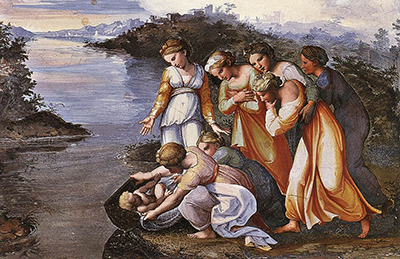Moses saved from the water painting was commissioned in the year 1512, and it was one of Raphael's last artistic work.
It was a truly extraordinary painting intended to decorate Palais du Louvre workshops. This work was one of the beautiful and finest revivals that Raphael brought to the art industry. In the painting, the landscape occupies a significant section of the central point which was common in the art tapestry. The column and the trees create vanishing lines that seem to open up space. Moses saved from the water is a painting that coincided with the use of the Italian oil paint. Most of his early work was executed on the panel. In most cases, egg tempera was used by Raphael, and it was a colour mixture common with many artists of this period including his master Perugino. Before settling in Rome, the Italian artist's most paintings were executed on animal skin or numerous sheets of paper.
Raphael is believed to have performed several experiments with the available oil in order to achieve beautiful and richer colours associated with the medium. Those experiments also helped him to achieve a significant depth of shadow in his paintings. Raphael employed various artists and assistants to help him come up with the painting. Most of the work was performed by his assistants, but it is believed that he intervened in various stages including the final one.
While in Rome, his painting style developed due to the influence of Venetian painting. In this painting, he used colour and light as the main pictorial elements that were independent of form and the lime. He developed idealized features and various rounded shapes of five young women and to the gentleness of the available individuals. The border of the Moses Saved from the water is created in monochrome as in the bas-relief. He combined putti with the classical-style arabesques, foliage, and medallions which are all expressed in a range of light and luminous shades. Raphael did not hesitate to allow the items in the painting to extend beyond the drawing material border.
The painting depicts five young women with baby Moses in a basket floating on water. At the bottom of the painting, Pharaoh’s beautiful daughter is well dressed in a robe with a blue cloak and a gold ground. She is on the ground, making a gesture of joy at seeing the baby. Pharaoh's daughter is concealed by two young women. Just behind the group, you can easily see ruins and columns that close off the entire landscape to the right. When you look at the left, the Nile is flowing, and Raphael provided a clear view into space through the beautiful trees along the banks.




